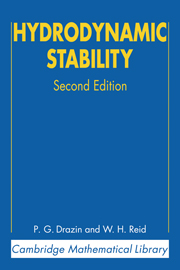Book contents
- Frontmatter
- Contents
- Foreword by John Miles
- Preface
- 1 INTRODUCTION
- 2 THERMAL INSTABILITY
- 3 CENTRIFUGAL INSTABILITY
- 4 PARALLEL SHEAR FLOWS
- 5 UNIFORM ASYMPTOTIC APPROXIMATIONS
- 6 ADDITIONAL TOPICS IN LINEAR STABILITY THEORY
- 7 NONLINEAR STABILITY
- APPENDIX: A CLASS OF GENERALIZED AIRY FUNCTIONS
- Addendum: Weakly non-parallel theories for the Blasius boundary layer
- Solutions
- Bibliography and author index
- Motion picture index
- Subject index
5 - UNIFORM ASYMPTOTIC APPROXIMATIONS
Published online by Cambridge University Press: 06 August 2010
- Frontmatter
- Contents
- Foreword by John Miles
- Preface
- 1 INTRODUCTION
- 2 THERMAL INSTABILITY
- 3 CENTRIFUGAL INSTABILITY
- 4 PARALLEL SHEAR FLOWS
- 5 UNIFORM ASYMPTOTIC APPROXIMATIONS
- 6 ADDITIONAL TOPICS IN LINEAR STABILITY THEORY
- 7 NONLINEAR STABILITY
- APPENDIX: A CLASS OF GENERALIZED AIRY FUNCTIONS
- Addendum: Weakly non-parallel theories for the Blasius boundary layer
- Solutions
- Bibliography and author index
- Motion picture index
- Subject index
Summary
It is in the nature of Applied Mathematics that one should be concerned not only with the application of existing mathematical theories and methods, but also with the stimulation of new mathematical problems, through the study of interesting problems in science, and the attempts to solve these problems.
– C. C. Lin (1964)Introduction
The approximations to the solutions of the Orr–Sommerfeld equation which were derived in § 27 suffer from two major defects. First, the approximations (except for the regular inviscid solution) are not uniformly valid in a full neighbourhood of the critical point and, second, the theory does not lead to a systematic method of obtaining higher approximations. In this chapter, therefore, we shall describe some of the attempts which have been made to overcome these deficiencies of the heuristic theory. These improved theories have generally been based on either the comparison-equation method or the method of matched asymptotic expansions. Although neither method is entirely satisfactory by itself, both have played important roles in the development of the subject.
The comparison-equation method has been extensively studied by Wasow (1953b), Langer (1957, 1959), Lin (1957a,b, 1958), Lin & Rabenstein (1960, 1969) and others. In all of this work the major aims have been to obtain asymptotic approximations to the solutions of the Orr–Sommerfeld equation which are uniformly valid in a bounded domain containing one simple turning point and to develop an algorithm by which higher approximations can be obtained systematically.
- Type
- Chapter
- Information
- Hydrodynamic Stability , pp. 251 - 319Publisher: Cambridge University PressPrint publication year: 2004

